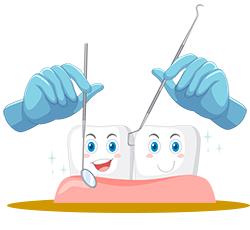Tongue Tie / Ankyloglossia
Ankyloglossia, sometimes referred to as tongue tie, is an oral ailment that affects a child's ability to move their tongue freely from birth. A structural anomaly of the lingual frenum called tongue-tie. You must be asking yourself what the heck the lingual frenum is. Okay, let's start at the beginning. To explain tongue-tie, let's talk about the basic anatomy around the tongue and how it affects how the tongue works.
Fluoride treatments in Nashik are typically professional procedures that a dentist or dental hygienist applies to a patient's teeth to enhance oral health and lower the risk of cavities. However, only when specifically instructed by a dentist are patients able to use some high-concentration fluoride treatments at home.
Structural Abnormality Causes Tongue-Tie.
We refer to the membrane that connects your tongue to the bottom of your mouth as the "Lingual Frenum." It serves the purpose of holding the tongue firmly against the mouth's roof. This makes it possible for the tongue to move in a way that supports appropriate chewing, speaking, and other tasks.
The lingual frenum should ideally be elastic so that it does not obstruct the tongue's ability to move while sucking, chewing, swallowing, etc. The normal mobility of the tongue is impeded when it is short, thick, tight, wide, or extends beyond the margin of the tongue. We refer to this disorder as the Tongue Tie since it negatively impacts oro-muscular function, feeding, speaking, and other things.
Does my child have a tongue tie?
This is possible in two different ways. In the beginning, by observing the tongue and lingual frenum (signs). Second, keep an eye on any problems (symptoms) your child may be experiencing.
Signs to look for:
1. Your child has trouble sticking out his tongue.
2. When your youngster sticks out their tongue, it seems notch-shaped or heart-shaped.
3. They have trouble shifting their tongue from one side to the other.
4.The tip of your child's tongue should not extend past the border of their lower lip or to the roof of their mouth.
Symptoms to look for:
1. Difficulty latching on or maintaining a connection to your breast.
2. Your child appears to be hungry all the time and is uneasy.
3. Not gaining the necessary amount of weight.
4. Feeding while making a "clicking" noise.
How is tongue tie treated?
As you may have already realised, we must remove the tongue's lingual frenum in order to treat the problem. It is referred to as a frenotomy in medicine. The tongue is given complete freedom to carry out all necessary tasks when the connective tissue (frenum) is cut.
The first step of the operation is to make the youngster comfortable for the treatment by applying anaesthesia to numb the area. The frenulum is then delicately sliced using a laser. Unlike other oral procedures, most frenotomies don't require stitches, and the recovery time is short.
How Do I Care for My Child's Teeth After Fluoride Varnish is Applied?
These broad recommendations will help you care for your child’s teeth once fluoride varnish has been applied. For any additional particular instructions, check with your child’s doctor.
- After the fluoride varnish has been administered for 45 minutes, your youngster is free to eat and drink. However, only serve soft foods and cold or warm (not hot) liquids to your toddler.
- Wait at least 4 to 6 hours before brushing or flossing your teeth. It is best to put off brushing or flossing until the morning.
Steps to good dental health
- Regular dental visits with a paediatric dentist
- Obtaining adequate fluoride
- routinely flossing and brushing
- eating healthy
Need Help?
Please make an appointment with our doctor or speak with our front desk..
What our Happy Parents Say
Great service as child dentist, his way of treatments are nice.
One must visit for any tooth problems of children.
Thanks for treating my both children
After treatment they now can enjoy food and found great improvement in health.

Subhash Gaikwad
My son Aaradhya is a 4 years old, I worried about his teeth due to lot of pain but doctor given the proper solution. We are very happy about doctors root canal treatment. Treatment is very nice and without pain under laughing gas.. new concept in dental clinic..Doctor is very talented and sincere about his work. Thank you.

Amol Lokhande
My daughter felt very comfortable and friendly with doctor and hospital staff throughout procedure. After procedure consultation and follow up experience was great. Highly recommend for padiatric dentistry in Nashik.

Kripa Sindhu Saha






